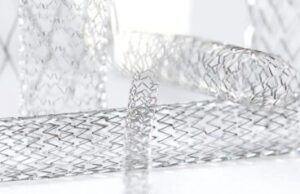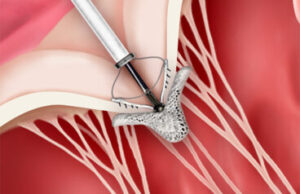What is nitinol and where is it used?
Nitinol is a nearly equiatomic metal alloy of nickel and titanium with unique properties, including superelasticity (also called pseudoelasticity) and shape memory.

Nitinol — a nickel-titanium alloy — is used for medical devices such as stents, heart valves, catheters and orthopedics. [Photo via Adobe Stock]
Superelasticity/pseudoelasticity means medical-grade nitinol shows great elasticity under stress and can snap back to its original shape when pressure is released.
Nitinol’s superelastic properties allow medical devices using it to compress to a lower profile when being placed in a patient using a catheter. Implants made of nitinol such as heart valves expand to their intended size and shape at the site of implantation and remain inside the patient, while nitinol therapy devices such as ablation catheters expand inside the body, treat targeted tissue, and then compress again for retrieval.
Shape memory means medical-grade nitinol can remember its original shape and return to it when heated. For example, some catheter-delivered implants are designed to expand to their pre-formed shape at body temperature for permanent placement.
A promising application of nitinol’s shape memory properties is under development by heart failure startup Adona Medical, which is working on a heart shunt device that can be adjusted for variable flow rates.
“With an increasing trend to treat patients using minimally invasive procedures, nitinol has become a popular choice of material due to its ability to return to its original shape after being mechanically deformed or after heat is applied,” the FDA said in a nitinol guidance document. “These properties are due to reversible transformations between the austenite and martensite phases, which may be temperature-induced (shape-memory) or stress-induced (pseudoelasticity). As a result, nitinol can withstand greater amounts of reversible deformations without plastic deformation than conventional metallic alloys, such as stainless steel, titanium, or cobalt-chrome alloys.”
Nitinol medical devices include:
- Implantable cardiac devices, such as the frames of replacement heart valves that can be placed using catheter delivery (Medtronic’s Harmony valve is one example), Abbott’s implantable clips to repair leaky heart valves, or CroíValve’s tricuspid valve repair implant. V-Wave (set to be acquired by Johnson & Johnson MedTech) has developed an investigational interatrial shunt with nitinol for heart failure. Surgical robotics developer Capstan Medical uses nitinol to expand and anchor the catheter-delivered heart valves its developing.
- Stents and stent retrievers, such as the Johnson & Johnson MedTech Embotrap device for removing blood clots (thrombectomy) in ischemic stroke patients, Retriever Medical’s nitinol basket catheters, and self-expanding pediatric stents under development

This illustration shows the nitinol frictional elements on Abbott TriClip’ grippers securing a tricuspid heart valve’s leaflets. [Image courtesy of Abbott]
- Cardiac pulsed field ablation (PFA) catheters such as those developed by Medtronic, Affera (purchased by Medtronic, these catheters use nitinol both to expand inside a patient’s heart and as electrodes for generating the energy fields), Boston Scientific, J&J MedTech’s Biosense Webster and Abbott.

Medtronic’s Affera Sphere-360 pulsed field ablation catheter is adjustable, allowing the nitinol electrode to take different shapes inside a patient. [Illustration courtesy of Medtronic]
- Renal denervation (RDN) systems that treat hypertension, such as Medtronic’s Symplicity Spyral radiofrequency catheter and the needles that deliver alcohol in Ablative Solutions’ Peregrine catheter
- Synchron‘s catheter-placed Stentrode brain-control-interface implant
- Peripheral intervention devices such as LimFlow’s first-of-its-kind system for avoiding amputations due to chronic limb-threatening ischemia
- Dentistry, especially in orthodontics for wires and brackets that connect the teeth. “Sure Smile” dental braces are an example of its application in orthodontics.
- Endodontics, mainly during root canals for cleaning and shaping root canals
- In colorectal surgery, nitinol is used in various devices for reconnecting the intestine after a pathology is removed.
- Orthopedic implants
- Surgical robotics, such as this prototype for pediatric brain tumor procedures
- Wires for marking and locating breast tumors
- Tubing for a range of medical applications
- Dissolvable devices (in research at MIT)
- Mechanical actuation to fight muscle atrophy (in research at Harvard)
How did nitinol get its name?
The name “nitinol” comes from the metals nickel and tItanium plus “NOL” for Naval Ordnance Laboratory. That’s the U.S military explosives testing facility (now known as the Naval Surface Warfare Center) in White Oak, Maryland, where nitinol was developed. Fun fact: The former NOL facility in White Oak is now the FDA’s headquarters.
Article source: Medical Design & Outsourcing









